Physical Address
304 North Cardinal St.
Dorchester Center, MA 02124
The annual incidence of venous thromboembolism, including both deep vein thrombosis (DVT) and pulmonary embolism, is estimated at 300,000 to 600,000 per year. Postthrombotic syndrome (PTS) is a common late complication of lower extremity DVT. The incidence of PTS is approximately 40% in adult patients with a symptomatic first episode deep venous thrombosis (DVT) within 2 years. Early clot lysis may prevent or significantly decrease the incidence and severity of PTS after acute lower extremity deep vein thrombosis (DVT). Catheter-directed thrombolysis for DVT has proved to be a safe and effective method to remove acute iliofemoral DVT. Mechanical thrombectomy has emerged as an alternative or adjunct to pharmacologic thrombolysis.
It is thought that approximately 10% of patients with lower extremity DVT will have iliac vein involvement; these patients have an especially high risk of developing severe PTS, and this may vary significantly. A 2010 article from a large tertiary care facility found that 24% of patients diagnosed with DVT did have involvement of the iliac veins. Patients with iliac vein thrombosis have a much worse prognosis.
According to the Society of Interventional Radiology Quality Improvement guidelines, patients undergoing endovascular thrombus removal for lower extremity DVT should have imaging-proved DVT in the inferior vena cava (IVC) or iliac, common femoral, or femoral vein in a recently ambulatory patient where there is a strong clinical suspicion for recently formed DVT ( Table 70.1 ). Furthermore, based on clinical experience, catheter directed therapy (CDT) is recommended as first-line therapy for patients with DVT causing acute limb-threatening circulatory compromise.
| Indications |
| Imaging-proved symptomatic DVT in the IVC, iliac, common femoral, and/or femoral vein in a recently ambulatory patient with DVT symptoms for less than 28 days or in whom there is strong clinical suspicion for recently formed (less than 28 days) DVT. |
| Absolute Contraindications |
| Active internal bleeding or disseminated intravascular coagulation |
| Recent cerebrovascular event (including TIA), neurosurgery (intracranial, spinal) or intracranial trauma (<3 mo) |
| Contraindication to anticoagulation |
| Relative Contraindications |
| Recent cardiopulmonary resuscitation, major surgery, obstetrical delivery, organ biopsy, major trauma, or cataract surgery (<7–10 days) |
| Intracranial tumor, other intracranial lesion, or seizure disorder |
| Uncontrolled hypertension: systolic BP > 180 mm Hg, diastolic BP > 100 mm Hg |
| Recent major gastrointestinal bleeding (<3 mo) |
| Serious allergic reaction to thrombolytic agent, anticoagulant, or contrast media |
| Severe thrombocytopenia |
| Known right-to-left cardiac or pulmonary shunt or left-sided heart thrombus |
| Severe dyspnea or severe acute mental illness |
| Suspicion for infected venous thrombus |
| Renal failure |
| Pregnancy or lactation |
| Severe hepatic dysfunction |
| Bacterial endocarditis |
| Diabetic hemorrhagic retinopathy |
A limited number of practitioners use thrombolytic therapy in conjunction with iliac vein recanalization in patients with chronic iliac vein thrombosis or subacute thrombosis. This practice is discouraged and probably has limited benefits in this group of patients.
Phlegmasia cerulea dolens , an acute fulminating form of DVT characterized by reactive arterial spasm, pronounced edema, severe cyanosis, petechiae, and purpura, carries a high risk of amputation and significant morbidity and mortality. Many patients have significant comorbid factors such that any correctible management—surgical, endovascular, or medical—carries high risk. Several case reports of CDT for phlegmasia cerulea dolens have been published describing good short-term clinical improvement. CDT is found to be justified for most patients with this condition if they do not have a high risk of bleeding. When bleeding risk is believed to be prohibitory for thrombolysis, surgical thrombectomy should be considered. This is regarded as an emergent procedure.
Acute thrombosis of the IVC is often symptomatic, leading to bilateral lower extremity leg and genital congestion. If the thrombosis extends above the renal and hepatic veins, renal failure and Budd-Chiari syndrome may result. Filter placement may not be possible to prevent pulmonary emboli. For these reasons, CDT may be justified to prevent or relieve the sequelae mentioned earlier.
Contraindications to venous thrombolysis and mechanical thrombectomy are practically the same as for any other thrombolytic therapy and are listed in Table 70.1 .
The equipment needed is the same as that used for arterial thrombolysis. Additional equipment is needed for mechanical thrombectomy. The main items needed are listed in Table 70.2 .
| Imaging Equipment |
|
| Guidewires and Catheters |
|
Ultrasound to guide venous access is required, especially when the popliteal vein or posterior tibial vein is used for access. Puncturing the artery inadvertently can have serious consequences when the thrombolytic therapy subsequently starts. For venous access it is advisable to use a micropuncture access set. A 21-gauge needle with a 0.018-inch guidewire and 5F coaxial dilator that accepts a 0.035-inch guidewire is available from many vendors. There are many guidewires available, but the basic system is a 0.035-inch guidewire system. A multipurpose guidewire such as the Bentson (Cook Medical, Bloomington, IN) can be used, but a glide-coated guidewire such as the Glidewire (Terumo Medical Corp., Somerset, NJ) may be needed to negotiate thrombotic veins. To facilitate navigation through the clot, a 5F angiographic catheter, preferably with glide coating, should be used to help direct the guidewire as it is passed through the clotted vein. Contrast medium can be intermittently injected through it to obtain venography as it is advanced. An introducer sheath should be used that is 1F size larger than the infusion catheter so heparin solution can be infused through the side port around the infusion catheter going through it, either for low-dose anticoagulation or to keep the sheath from forming thrombus. There are many brands available, and a 10-cm-long introducer is sufficient. If mechanical thrombectomy is used, a larger introducer is needed, which is then left in place during the following infusion. Selection of an infusion catheter is based on the length of the clot to be treated. There are many different brands offered, but most are available with a 5-, 10-, 20-, 30-, 40-, and 50-cm-long infusion segment and come in 5F diameters, although some are also available in a 4F diameter. Construction of individual catheters differs, but the most important property is equal distribution of the drug throughout the length of the infusion segment.
The large number of mechanical thrombectomy devices available may be an indicator of their shortcomings thus far. They can be divided into so-called wall contact devices and non–wall contact devices ( Table 70.3 ). Many of the devices have undergone preclinical and clinical evaluation for DVT and have been found to be effective, with very little trauma to the valvular elements, which is one of the main concerns. Concomitant pulmonary emboli have been one of the concerns with mechanical thrombectomy, and placement of an IVC filter has been recommended with some devices.
| Wall Contact Devices |
| Arrow Percutaneous Thrombectomy Device (Arrow Medical Systems, Reading, PA) MTI-Castaneda Brush (Microtherapeutics, San Clemente, CA) Cragg Brush (Microtherapeutics) |
| Non–Wall Contact Devices |
| Rotarex catheter (Straub Medical, Wangs, Switzerland) AngioJet (Boston Scientific, Marlborough, MA) Oasis (Boston Scientific) Hydrolyzer (Cordis Corp., Warren, NJ) Trellis Reserve (Bacchus Vascular, Santa Clara, CA) |
The anatomy of the lower extremity, iliac veins, and IVC is familiar to all interventionists, but the nomenclature of some of the lower extremity veins has changed over time. The following is a short practical review with correlation to the approach for venous thrombolysis. It is important to recognize that the anatomy of the lower leg veins varies.
The three leg veins are paired and travel parallel to the main leg arteries and bear the same names: the posterior tibial vein , anterior tibial vein , and fibular or peroneal vein . The posterior tibial vein pair traverses behind the medial malleoli with the posterior tibial artery. The anatomy here is important because access can be gained into the posterior tibial vein at this level. This access can be used for placement of infusion catheters through which thrombolytic agents can be infused into thrombosed popliteal vein. The deep leg veins communicate with the superficial veins via perforating veins . The perforating veins have been used for placement of infusion catheters into thrombosed deep veins. The leg veins will then merge and form the popliteal vein . The vein is often partially or entirely duplicated.
The small saphenous vein (formerly the short saphenous vein) is formed from the dorsal venous arch and travels subcutaneously between the two heads of the gastrocnemius muscle. It then penetrates the fascia to enter the popliteal fossa and joins the popliteal or femoral vein, most commonly above or at the level of the femoral condyles. The small saphenous vein is useful as an access vein for thrombolysis if the thrombus extends no farther distal than the mid- to distal femoral vein. One has to be aware of variation in the connection of the small saphenous vein, which may join the deep system above the popliteal vein, which will affect the use of this access if thrombus extends caudal to the junction. The sural nerve is just lateral to the vein, and precaution has to be taken not to harm it during puncture.
The femoral vein is quite consistent even though it can be duplicated (21.2%) or even have multiple channels (13.8%). Usually only one infusion catheter is placed, so in the case of a split femoral vein, one has to select one channel to infuse into. The femoral vein will then merge with the profunda femoris vein , forming the common femoral vein. One major branch drains into it, the great saphenous vein . The transition to the external iliac vein is at the inguinal ligament and the deep circumflex iliac vein, which is a tributary and anatomic landmark. As the internal iliac vein joins the external iliac vein, the common iliac vein is formed. The right and left common iliac veins will subsequently form the inferior vena cava , which will ascend to the right and anterior of the spine to the right atrium. A variant that is commonly seen with iliac vein thrombosis is compression of the left common iliac vein by the right common iliac artery crossing it anteriorly. Commonly, a stenosis is present at this point in the left common iliac vein, and the vein is often septate or webbed, which causes partial or complete obstruction with variable collateral formation. It has been estimated that between 14% and 30% of these patients have May-Thurner syndrome. May-Thurner syndrome is defined as the extrinsic compression of the left common iliac vein by the right common iliac artery, which results in chronic venous insufficiency causing acute pain and left lower extremity swelling in symptomatic patients.
Access for venous thrombolysis and/or mechanical thrombectomy depends largely on the location and extent of the thrombus. A known history of previous thrombosis (areas of chronic thrombosis) will also play a decisive role in selecting access, because it is difficult to traverse chronically thrombosed vein to get to an acute thrombus for treatment. The main access sites are the right internal jugular vein, common femoral veins, popliteal veins, small saphenous vein, and posterior tibial veins. Other accesses will be mentioned later.
The right internal jugular vein was the access vein of choice during the infancy of the procedure. As interventionists became more experienced, the trend swayed subsequently to popliteal vein access (or small saphenous vein) and the posterior tibial vein.
The right internal jugular vein is easily accessed using ultrasound guidance. For isolated iliac vein thrombosis it is, as a general rule, easy to traverse the acute thrombus from the jugular vein. Infusion catheters placed from that access will easily span the length of isolated iliac vein thrombus. If an IVC filter is needed, it can be placed at the same time from the jugular vein. The filter will then be in the path of the infusion system, but this can be overcome by using introducer sheaths that extend beyond the filter. Thrombus sitting even further distal (i.e., in the femoral and even the popliteal vein) causes difficulties if jugular vein access is used. In this case, the valves in the femoral veins have to be traversed retrograde, which is a difficult task because the wire and catheters preferentially sit in the sinus rather than pass through the valve opening.
It was for these reasons practitioners started favoring access from the popliteal vein; popliteal access is easily achieved and well tolerated by the patient. The vein sits superficial to the artery in the popliteal fossa and is usually not very deep. Ultrasound guidance is necessary, and use of a micropuncture access system is recommended.
But what do you do in the case of clot extending into the popliteal vein and distal to that? This is a dilemma many operators have solved by puncturing the posterior tibial vein behind the medial malleoli and placing a second infusion system (in addition to the popliteal vein). This infusion part of the infusion catheter has to be long enough to overlap the infusion catheter from the popliteal vein. Usually a 40- to 50-cm infusion-length system will do that.
The popliteal vein is the preferred access site. Posterior tibial vein access and even jugular vein access are still used occasionally, often in conjunction with popliteal vein access. The jugular vein is only used in rare cases of IVC thrombosis and isolated iliac vein thrombosis. For the popliteal vein approach, the patient is placed prone ( Fig. 70.1 ) on the procedure table. Although not routinely indicated, the vena cava filter can be placed from the jugular vein with the patient supine before turning the patient prone to gain access to the popliteal vein. Filters can also be placed from the thrombolysis access in the common femoral vein or even the popliteal vein as needed.
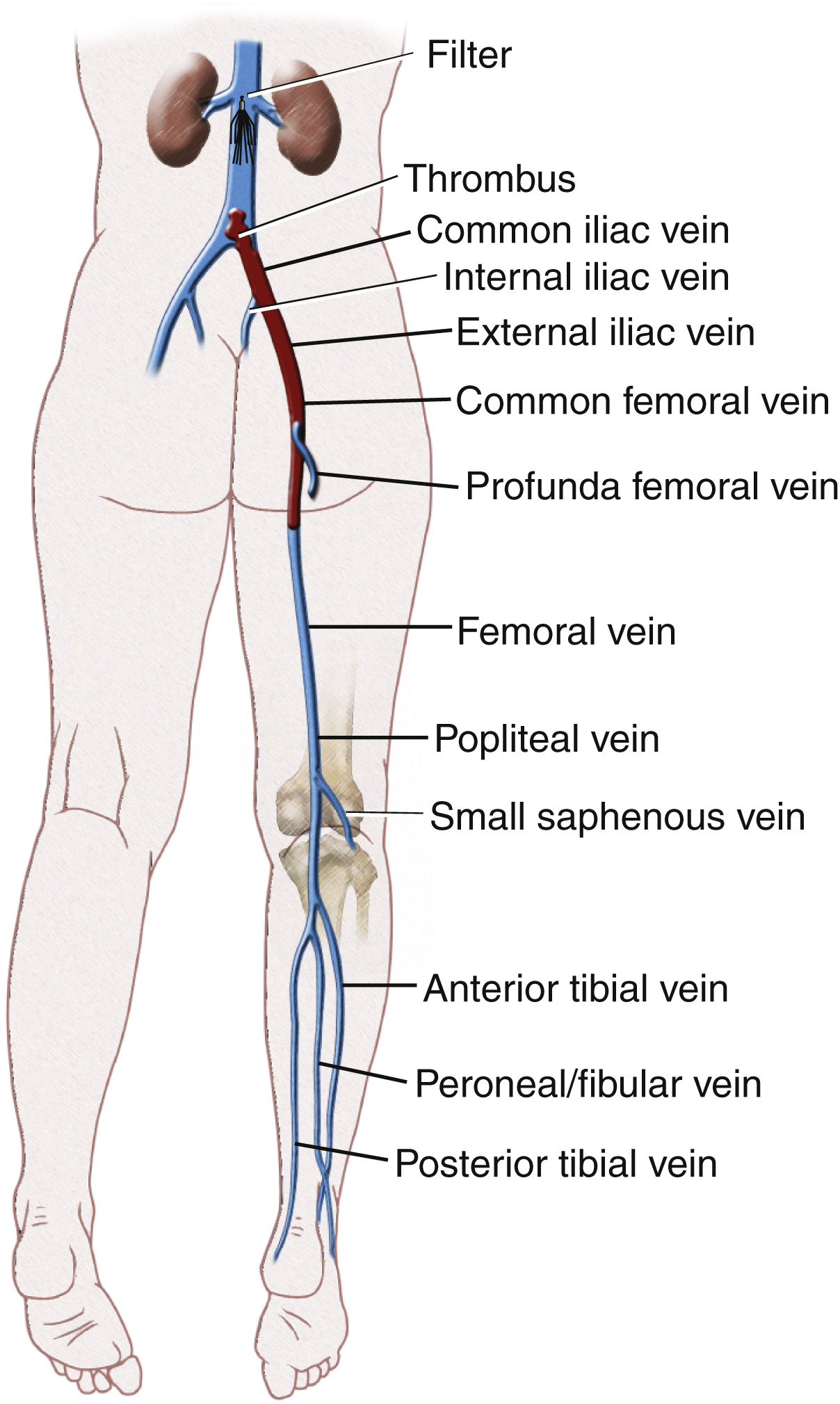
Ultrasound should always be used for guidance during access when thrombolysis is anticipated. Ultrasonography prevents inadvertent puncture of the artery or puncture into a vein that cannot be used for access purposes. These puncture sites may later cause bleeding complications. As soon as access has been gained, an introducer sheath is placed. Usually either a 5F or 6F introducer sheath is used, but if mechanical thrombectomy is to be used, a larger introducer sheath may be needed ( Fig. 70.2 ). When the introducer sheath has been placed, the clot has to be traversed to the most central portion. Contrast is injected from the introducer to evaluate the distal portion of the thrombus ( Fig. 70.3 ). The guidewire and angiographic catheter are advanced through the clot, and as progress is made, the wire can be intermittently removed and contrast agent injected.
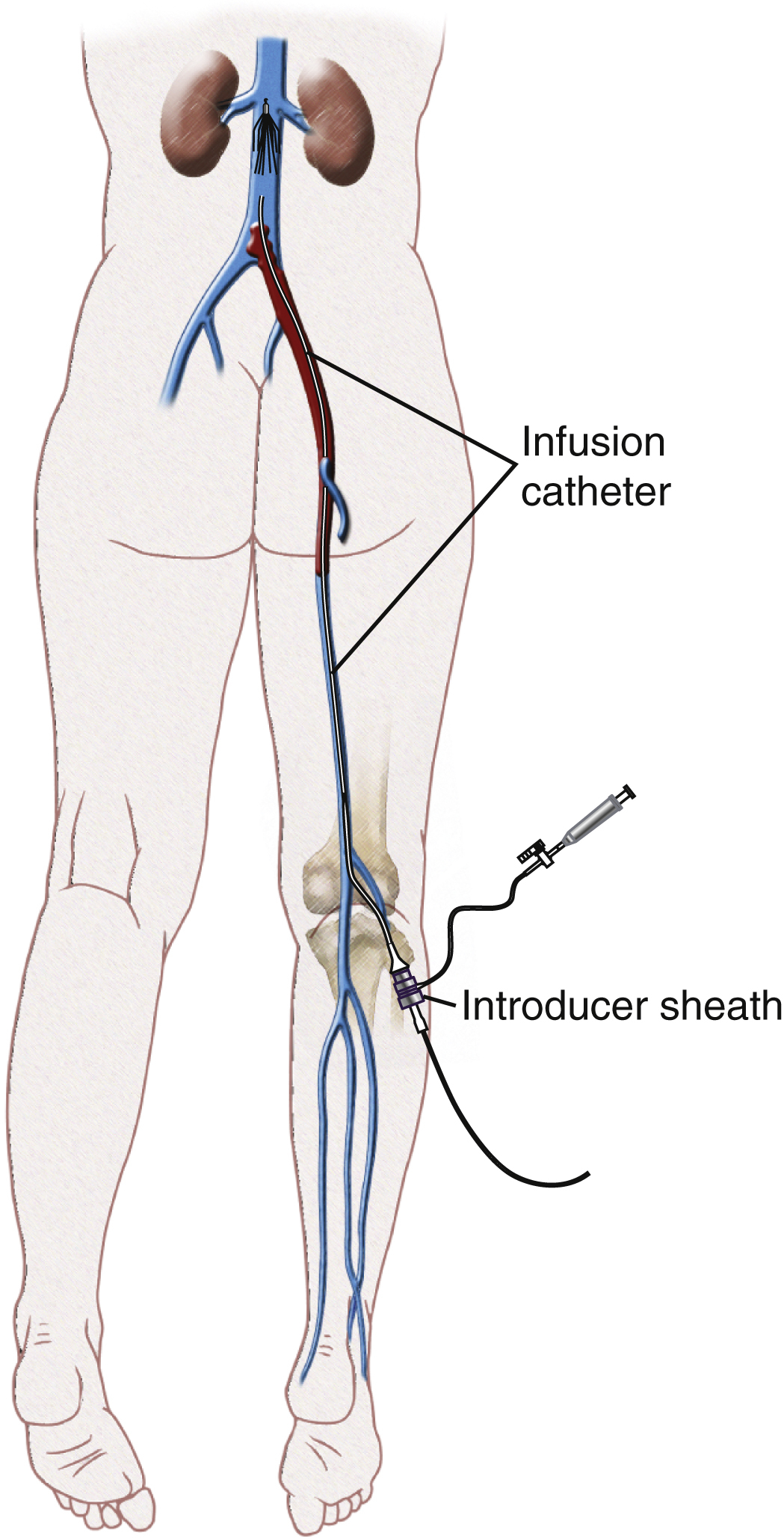
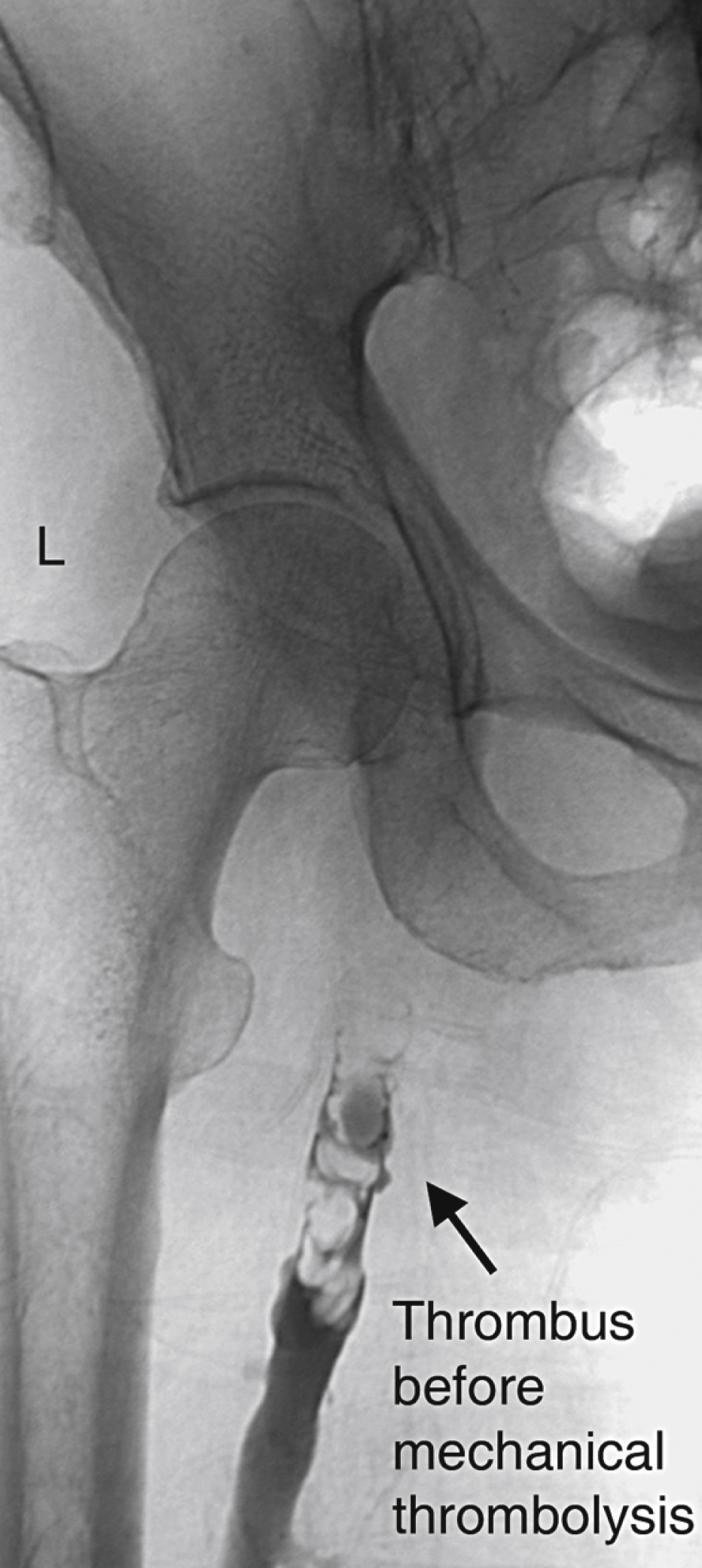
When the catheter has reached the most proximal or central extent of the thrombus, a venogram should be performed. If the thrombus extends to the upper end of the common iliac vein, a good inferior vena cavogram should be obtained through the angiographic catheter. At this point the optimal length of the infusion catheter is selected. An infusion catheter should be selected that has an infusion segment of similar length to the length of the thrombus. The whole thrombus should be covered with infusion holes (infusion segment) ( Fig. 70.4 ; also see Fig. 70.2 ).
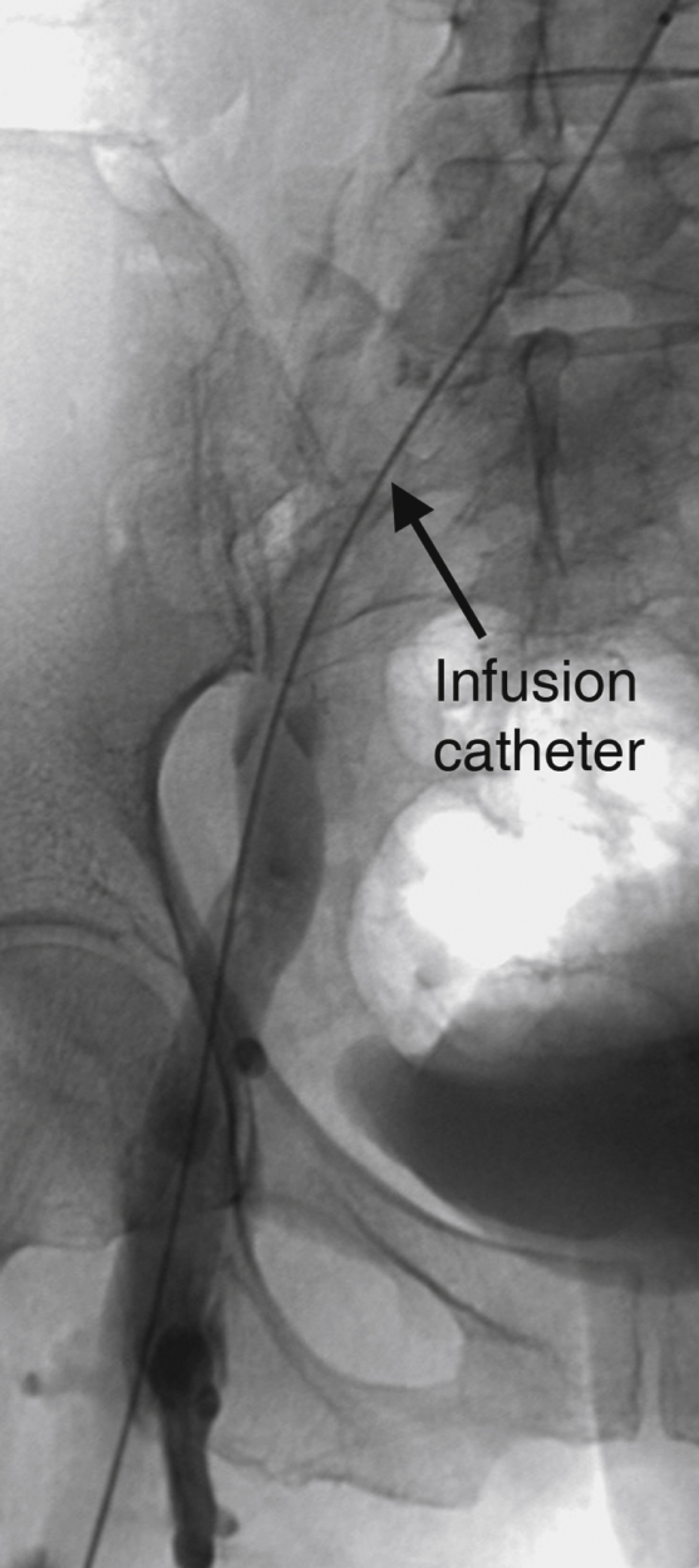
Heparin is usually infused through the introducer sheath, and if two accesses are used, the remaining introducer sheath is infused with normal saline with minimal amounts of heparin.
Thrombolysis by itself has been shown to be time consuming, taking between 53 and 75 hours with infusion alone ; it is expensive, and there is a risk accompanied with thrombolysis. Percutaneous mechanical thrombectomy (PMT) has the potential to solve these problems. The thrombus can be either completely removed with PMT or, as more often is the case, significantly debulked, followed with shorter infusion of the thrombolytic agent. A number of representative mechanical thrombectomy devices are available, as listed in Table 70.3 . The devices can be roughly divided into wall-contacting and non–wall-contacting devices. PMT can usually be performed through the same access site as the thrombolysis, most commonly the popliteal vein. After mechanical thrombectomy, thrombolytic infusion is still needed in most cases. An infusion catheter should be selected with an infusion length that covers the whole previously thrombosed area (see Fig. 70.4 ).
Not infrequently the thrombus extends beyond the distal femoral vein. Then it is impossible to use mechanical devices or expose the thrombus to the lytic drugs, because the introducer sheath usually covers the popliteal vein and the distal segment of the femoral vein. It has been advocated to actually try to go retrograde from the popliteal vein, which is difficult given that the valves are hard to pass retrograde. An alternative is to either puncture the posterior tibial vein by the medial malleoli or puncture a superficial vein and negotiate through perforators into the deep calf veins. For the posterior tibial vein, a linear ultrasound probe is used (preferably 10 MHz) to identify the posterior tibial vein pair on each side of the artery just behind the medial malleoli. This is done in the same setting as the placement of the popliteal vein access. A 5F or even a 6F introducer sheath can be placed, and usually 5F infusion catheters can be passed up the posterior tibial veins. Occasionally, especially in females, severe spasms will make it difficult to pass the infusion catheters. Subsequently, a Glidewire is passed all the way up to the femoral vein, and finally the infusion catheter is advanced high enough to slightly overlap the one from the popliteal vein. The most distal side hole (closest to the access) should be just above the tip of the introducer sheath. Usually the thrombolytic dose is then evenly split between the two infusion systems.
A separate infusion system is then placed from the popliteal vein, and infusion can then be given from two locations, the posterior tibial vein and the popliteal vein ( Fig. 70.5 ). The thrombolytic dose is then typically split into two even doses.
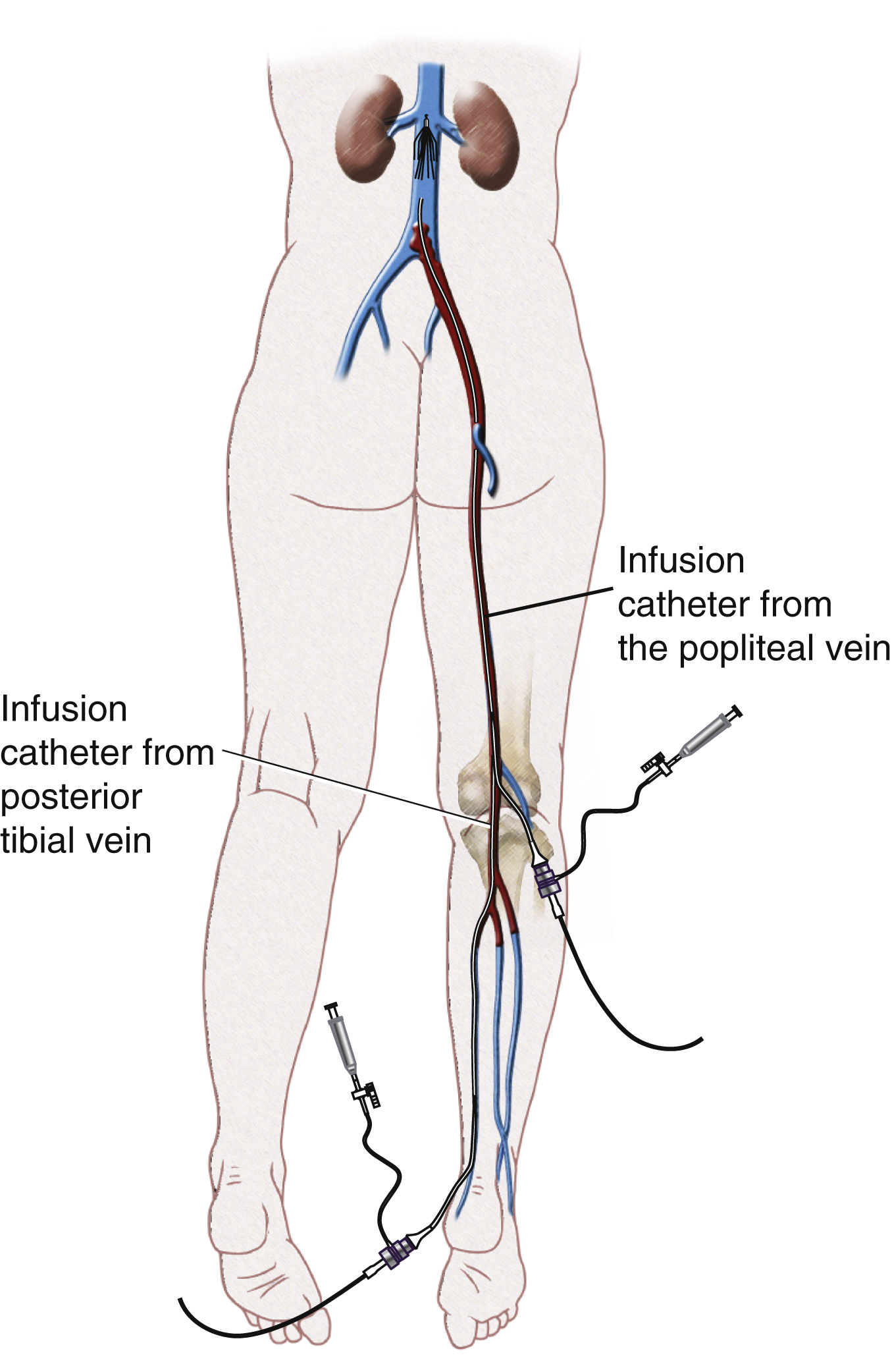
Infusion is usually continued for 8 to 20 hours or until it is convenient to bring the patient back to the procedure room. One can then inject contrast into either the introducer sheath or infusion catheter. At that point, based on the venogram, a decision has to be made whether or not further infusion is needed. It is debated what the endpoint should be. Some authors argue for the so-called open vein concept, which means practically all thrombus has to be removed. That in itself is a good target, especially in the femoral and popliteal veins, where one cannot expect the valvular elements to recover function if there is thrombus burden on them. This has not been proved. This often becomes a question of how long the patient has been infused with the thrombolytic agent, how old the clot is thought to be (and thereby likely to be lysed), and other comorbid factors.
In the iliac veins and even the common femoral veins, one might actually be tempted to stent areas that appear to be resistant to thrombolysis ( Fig. 70.6 ). If in doubt when considering the hemodynamic significance of a venous stenosis, there is not much literature to rely on. If collateral vessels fill around a narrowed vein, that usually indicates that the narrowed segment is hemodynamically significant (see Fig. 70.6A–B ), but one can also measure pressures across the segment. A pressure gradient above 3 mm Hg is often cited as a significant pressure gradient in the venous system ( Fig. 70.6C ). Stents are then commonly placed in the iliac veins, typically using 12- to 14-mm-wide self-expanding stents that cover the entire narrowed segment from the IVC as low as necessary down to the profunda femoral and origin of the great saphenous vein if required. The stents are then dilated to the diameter of the stent using an angioplasty balloon of that diameter. Stent placement and angioplasty can easily be performed from the popliteal vein using the same access as was used for the thrombolysis. The introducer may have to be upsized to accommodate the large diameter of the stent delivery system and balloon shaft size. Angioplasty alone is usually not believed to be adequate for dilation of venous stenosis in the lower extremities and pelvis. Many patients with left-sided iliac vein thrombosis have May-Thurner syndrome, which probably always requires stent placement ( Fig. 70.7 ).
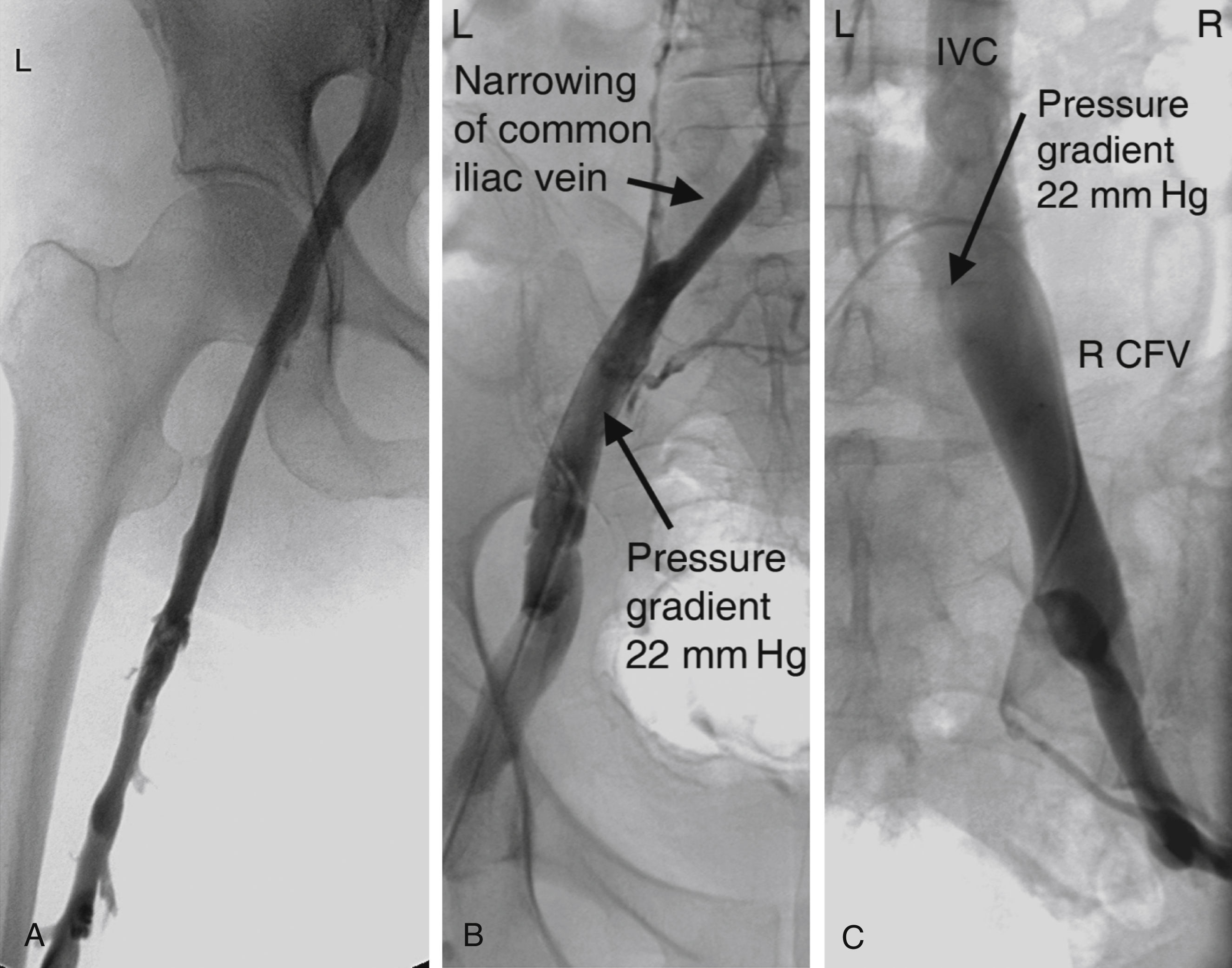
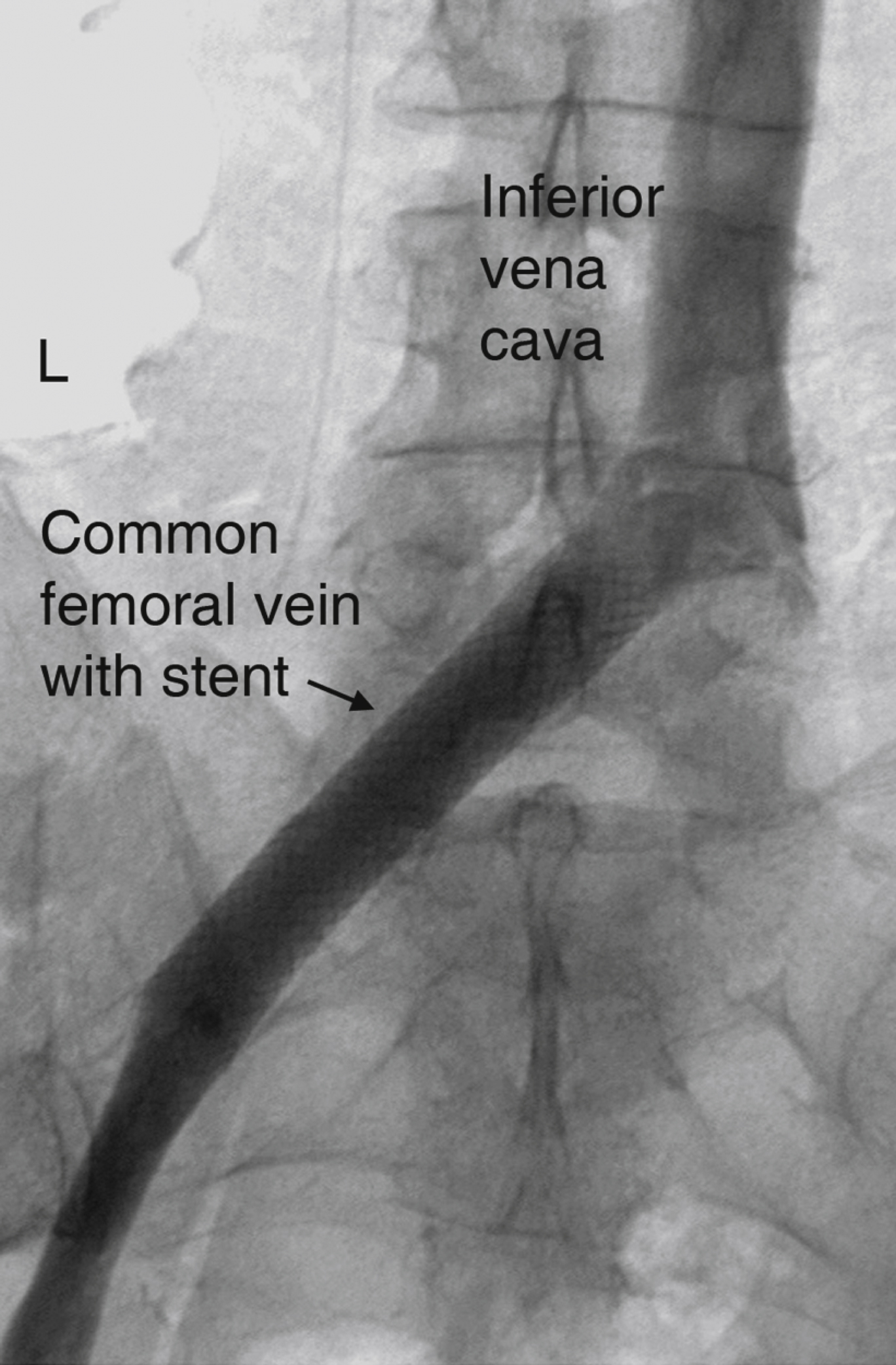
The most commonly used fibrinolytic drug is recombinant tissue plasminogen activator (rtPA, [Genentech, San Francisco, CA]). Urokinase (UK, Abbokinase [Abbott Laboratories, Abbott Park, IL]) is no longer available in the United States but is available in other countries and used there.
There have been several infusion regimens published, including pulse-spray, but there seems to be a consensus that slow infusion is the method of choice. Pulse-spray infusion fell into disfavor after anecdotal reports of fragmentation of the thrombus and concerns for pulmonary emboli as a direct consequence of the method were raised. Suggested rtPA dosing is 0.01 mg/kg/h with a maximal dose of 1.0 mg/h. When two or even more infusion catheters are used, the infusion is typically split between the infusion systems to make up the aforementioned dose. Heparin is given concomitantly for all thrombolysis. The authors’ practice is to infuse unfractionated heparin at 500 units/h via either a peripheral intravenous line or the side arm of the sheath. The patient is subsequently transferred to a unit with increased monitoring capabilities. Frequent vital signs and serial neurologic and limb checks are necessary. Complete blood count, prothrombin time, and partial thromboplastin time need to be drawn every 4 to 6 hours with a goal partial thromboplastin time of < 50 s during rtPA administration. Heparinization should be closely monitored because bleeding complications occur more commonly in patients who are aggressively anticoagulated during thrombolysis. Fibrinogen is also monitored at the same intervals given its direct association with hemorrhagic complications. A proposed approach is to reduce rtPA infusion by one-half if the fibrinogen level falls below 150 mg/dL or stop infusion if it falls below 100 mg/dL.
The Society of Interventional Radiology (2006) and the American Heart Association (2011) clinical practice guidelines suggest consideration of adjunctive CDT or percutaneous catheter directed therapy (PCDT) for select patients with extensive proximal DVT although the 2012 American College of Chest Physicians’ guidelines recommend anticoagulant therapy alone over CDT. Prevention of PTS is the goal of either therapy. Preventing DVT occurrence is the best method to prevent PTS. Therefore, evidence-based consensus guidelines suggest using pharmacologic or mechanical thromboprophylaxis to prevent venous thromboembolism in high-risk patients.
The CaVenT study (2012), a multicenter open-label randomized controlled trial that included 189 patients, examined rtPA infusion into the thrombus through a multi-sidehole catheter. CaVenT demonstrated a 26% reduction (55.6% vs 41.1%, P =.047) in the risk of developing PTS over 2 years’ follow-up in patients with iliac and/or upper femoral DVT who underwent CDT in addition to anticoagulation and compression, compared with anticoagulation and compression alone. Another study found that quality of life did not differ between patients treated with additional CDT compared with standard treatment alone. Patients who developed PTS reported poorer quality of life and more symptoms than patients without PTS.
The CaVenT study group followed these cohorts up to 5 years, at which time data was available for 176 patients. An absolute risk reduction of 28% was seen in patients who were treated with CDT versus those who received anticoagulation and compression stockings alone. There was no significant difference in quality of life scores in both the 2-year and 5-year follow-up studies.
The Acute Venous Thrombosis: Thrombus Removal with Adjunctive Catheter-Directed Thrombolysis (ATTRACT) trial was developed to determine whether PCDT prevents PTS after acute proximal lower extremity DVT. In this study, the first-line use of PCDT along with standard therapy versus standard therapy alone was compared in 691 patients. In this trial PCDT (1) had no effect on the development of PTS over 2 years, (2) reduced the severity of PTS over 2 years, (3) decreased the degree of leg pain and swelling within the first month after treatment, and (4) increased major bleeding within 10 days of treatment (absolute risk difference, 1.4%). The study investigators concluded that PCDT should not be used routinely as first-line DVT therapy.
Nevertheless, selective use of PCDT may be justified to reduce PTS severity in highly symptomatic patients younger than 65 years of age, with low expected risk of bleeding, and those who respond poorly to initial anticoagulant therapy. The authors of this study also postulate that patients with iliofemoral DVT will most likely make up a subgroup that benefits, because these patients have a higher baseline risk for PTS and are more likely to demonstrate poor symptom response to initial anticoagulation. Additionally, PCDT is recommended as first-line therapy for patients with DVT causing acute limb-threatening circulatory compromise.
Bleeding complications were the main reason for the cessation of systemic thrombolysis for DVT. Thrombolysis has also traditionally been looked at critically because of the potentially severe complications that can result from thrombolytic therapy.
Major bleeding was seen in 11% of the venous registry patients, the majority of which occurred at and around the introducer sheath (39%); 13% were retroperitoneal, and the remainder came from a variety of other sites. No deaths resulted from bleeding complications. In the University of Minnesota series, the major bleeding incidence was 7%. Pulmonary emboli were not specifically evaluated, so only symptomatic pulmonary emboli were detected. Pulmonary emboli occurred in 1 patient at the University of Minnesota, compared with 6 (1%) in the venous registry. One of the 6 patients died of pulmonary embolism. One patient in the venous registry suffered subdural hematoma, which was surgically managed. In addition to that, 1 patient died of intracranial bleeding. There is not much in the literature on mechanical thrombectomy, but Vedantham et al. did encounter three major bleeding complications in 22 treated patients (14%), including two patients who developed intramuscular hematomas requiring transfusions and a third patient who developed gynecologic bleeding and subsequently underwent endometrial curettage and ablation. None of the patients had any intracranial or gastrointestinal bleeding. With mechanical thrombectomy, hemolysis can be expected, but there are no reports of renal failure associated with the procedure. In the CaVenT study, there were two major complications out of the 49 that did receive thrombolytic treatment, one nerve damage and compartment syndrome. There were no major bleeding complications. In the ATTRACT trial there was a statistically significant difference in major bleeding complications (1.7% in PCDT group vs. 0.3% in the control group).
In general, the postprocedural care for patients after thrombolytic therapy for iliofemoral DVT should be the same as if they had been treated with anticoagulation alone. In other words, the patients should receive anticoagulation according to the DVT management protocol used. Use of elastic stockings is recommended, and follow-up is usually with ultrasonography of the deep veins of the affected limb and pelvic veins, as well as follow-up visits at 3 months, 6 months, and 1 year. Depending on the clinical situation, annual or biannual follow-up from then on may be all that is needed, including ultrasound evaluation. Patients should be encouraged to be physically active. If stents are placed, many centers advocate antiplatelet therapy for up to 6 weeks, but there is no literature to support this recommendation. A common drug used for this is clopidogrel (Plavix), 75 mg/day for 6 weeks. The rationale is taken from the coronary artery stent literature, which has demonstrated a lower rate of intimal hyperplasia if clopidogrel is given after coronary stent placement.
Become a Clinical Tree membership for Full access and enjoy Unlimited articles
If you are a member. Log in here